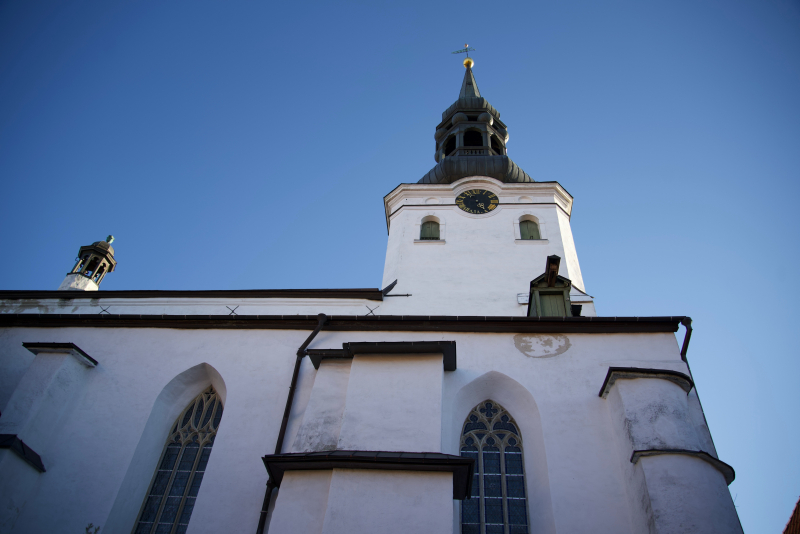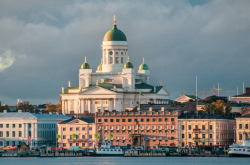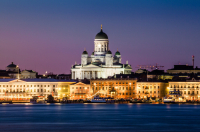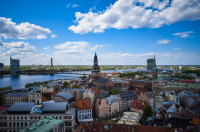I’ve been to Tallinn 15 or 16 times in the last ten years. I’ve strolled its curvy streets, climbed every accessible tower, but this city is still full of surprises for me. Something new pops up every time I go there. However, I’ve made my own list of must-sees, - eats and -walks that I follow while I am there. I share it with everyone who risks to ask me: “What do you recommend to see in Tallinn?”.
There are good official guides to Tallinn (my favorite is this one), but I’d like to offer you my personal guide to Tallinn and hopefully, you’ll make your own very soon.
Where to stroll
Practically every route in Tallinn starts at the Town Hall Square. I’d recommend you to visit it at the break of the day, you’ll be rewarded for your early awakening with the beautiful sight of colorful merchant houses, protected and crowned by the Town Hall Tower, not interrupted by tourist crowds and market stands. Summer (July and August) is the only period to take an opportunity to climb the Town Hall Tower to a 34 meters high belfry and enjoy breathtaking views over the square, Old Town streets, towers, and churches.
Do not forget to make a wish under Old Thomas, the weather vane that serves as a magical symbol of Tallinn since 1520. Then, go down and dive into the Square’s hodgepodge of people, souvenirs, flowers and plants, photos and street artists.
Opposite the Town Hall, near the Town Hall Pharmacy (working since 1422) you’ll see the miniature by-street that starts in the small archway and is hardly identified as a road. This narrow sideway gives you a full impression of how one armored knight (or a fat merchant) can halt all the traffic on the street. The unique Tallinn garlic-centric restaurant is situated there, so the odors on this street are also… authentically medieval.
Tip 1: Forget about high heels. Tallinn’s Old Town is all cobblestone. Add hills, stairs and towers and you’ll get the perfect heel-killing surface. Sneakers or walking shoes would be the best choice.
The sidestreet will lead you to the Pikk Street and to the beautiful Holy Spirit Church, built for the rich merchants of the Lower Town. I should mention that Tallinn was once divided into two parts: the Castle Hill (governed by Danish Knights) and the Lower (Merchant) Town, inhabited and governed by rich Hanseatic merchants. The Upper and Lower town were in a centuries-lasting competition, trying to show off who is more wealthy or mighty. So, the central merchant church, the Holy Spirit Church, has the most beautiful and precious decorations a merchant’s money could buy. Everything we love about Gothic we can find there: wonderfully carved wooden pictures, stained-glass windows, fresques and marble. Pikk (or “long”) Street starts from the Holy Spirit Church. Just take a walk down this street and enjoy all the best of medieval merchant houses: starting from the Great Guild Hall and The Brotherhood of Blackheads in the beginning of the street to the Three Sisters building ensemble at the end. The street ends with the Fat Margaret Tower and Great Coastal Gate, the biggest tower in Europe with walls 5 meters thick that in the Middle Ages successfully protected Tallinn from the invaders who wanted to capture the city's gold. From May until September, you can also take the stairs to the rooftop for a postcard view of the Tallinn harbor and Old Town.
Credit: google.com/maps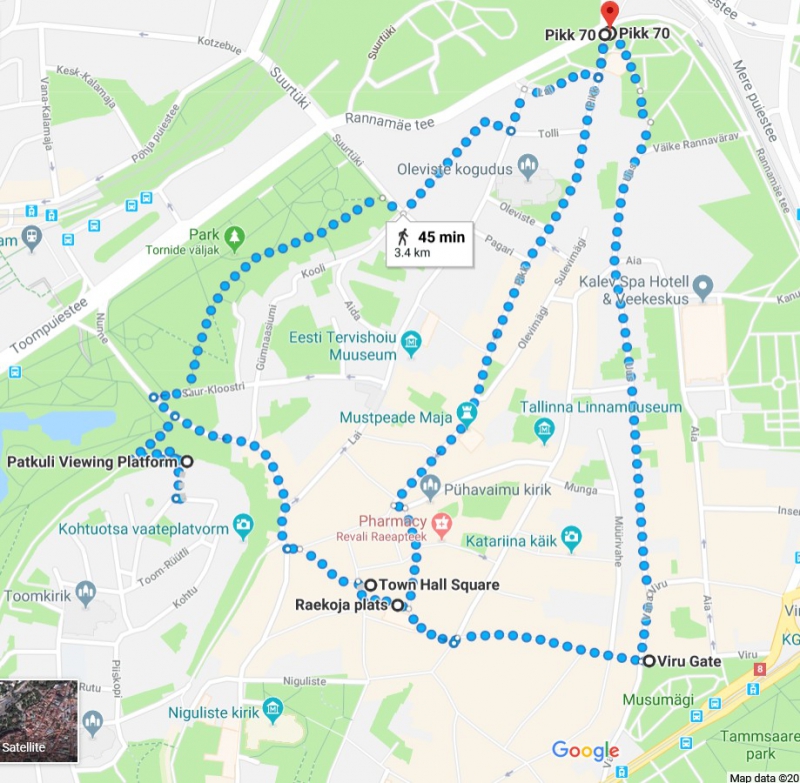
After the Fat Margaret, you may turn right, to the Uus (New) street, and walk past the city walls and houses that seem to "grow" out of the walls towards the Viru Gate and the famous wool market. There you can find a variety of traditional woolen and linen knitted crafts; it is just impossible to leave without a colorful warm beanie, a scarf or a pair of deer-adorned socks.
Near the market, take the stairs onto the City Walls for a picture-perfect view of the Gothic streets and red-tiled roofs.
If you turn left from the Fat Margaret and go through Danish King’s Garden you’ll see the city walls and towers from the other, Danish part of the city. These walls are accessible from the Nunne tower and you may climb and feel the authentic 600-year stone under your feet.
Near Nunne Gates, you’ll find the stairs to Castle Hill. I’d recommend you go this way to reach the Upper Town. You’ll see the enormous blocks of limestone of the 60 meters high wall and feel enormous respect for the skills and efforts of Middle-Age masons. The stairs will lead you to the Patkuli viewing platform. This is the best vantage point for viewing (and taking photos of) Old Town streets from the bird’s view, Town Wall and towers, St. Olav's Church and the harbors and Gulf of Tallinn. Beware of the seagulls. They are fearless thieves!
The highest building of the Toompea Hill (or Castle Hill) is the 69 meters high tower of the Cathedral of Saint Mary the Virgin (Dome Church). This was the knights’ church and you can compare its’ strict and laconic beauty with the richness of the Lower Town’s central church.
The best way to return to the Lower Town from the Castle Hill is Pikk Jag (Long Leg) street. This long and narrow (two armored knights’ width) street between two high walls was the only direct connection between the Lower and the Upper Town. It starts and ends with gates made of logs and iron, which were locked and guarded every night by soldiers. This should give you an idea of the relationship between the knights’ and merchants’ parts of Tallinn.
If you complete this route, you’ll make a full circle around Tallinn’s Old Town and get acquainted with its most popular attractions and sights. This route is good to start with. To discover Tallinn better I’d recommend to go without any particular route, turn to any sidewalk or curvy street and gather your own collection of hidden treasures.
Old Town. Credit: Karson (@karson_) on Unsplash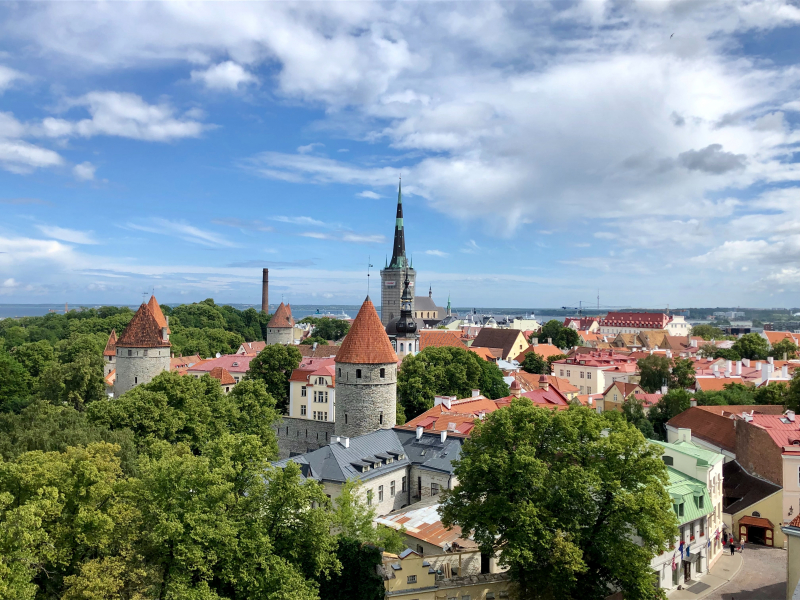
What to see
Even if you are not a fan of museums, Tallinn has a few worth visiting. The history of Tallinn and the life of its inhabitants is shown in History Museum (in Great Guild Hall), Tallinn City Museum and Kiek in de Kök Tower. My love belongs to the last one: a massive 38-meter high cannon tower with an extensive exhibition on the town's fortifications, weapons and medieval life. Where else would you be able to try Middle-Age weapons, beat on a guard’s drum or wear the costume of a plague doctor? In summer you can go from Kiek in de Kök Tower to four more city towers by the wall gallery and enjoy some coffee in the café on the roof of Maiden Tower (Neitsitorn).
Tip 2: Get a chance to dig deeper and discover Tallinn’s underbelly in hidden tunnels (Bastion Passages) that run underneath the old bastions of Toompea hill. Access to the tunnels starts from Kiek in de Kök Tower (pre-booking recommended in high season).
If you hate museums with all your heart, do not skip Lennusadam (Seaplane Harbour). This modern place, where practically everything can be touched, played with or tested is the perfect place to spend 3-4 hours or even more (my own high score is 5 hours). Museum (or better to say interactive space) includes the main building with real and authentic planes, submarines and cannons and an icebreaker in the nearest harbor. If you are in the company of boys from 10 months to 100 years, you’ll never be able to leave until they explore every inch of this place.
The museum has a nice café where sea wolves can have a break and feed their hunger and get ready for new discoveries. Lennusadam is very child-friendly and even has a newly-built playground made out of a real boat.
The smallest, but the tastiest museum is Marzipan gallery. It includes a small exhibition of marzipan sculptures and a marzipan sculpting workshop. While children make their own sweet masterpieces, you can enjoy coffee with one (or five/ten/many) version(s) of this delight.
Where and what to eat
Marzipan is not the only thing to eat in Tallinn. To be honest, it is very hard to be hungry in Tallinn. To be VERY honest, it is hard not to gain several kilos in Tallinn. (Now do you see why I am so persistent in offering you to climb one or another wall or tower?)
Food is everywhere: starting from delicious pastries and magically-scented sweet almonds roasted in spiced caramel at the Town Hall square and ending with substantial meals at Estonian Kitchen Restaurants.
Tip 3: Estonian meals were made to feed the hunger of farmers after a day of hard work or knights after the battle. When you order a plate for two in traditional Estonian restaurants, remember that it is, in fact, suitable for 3-4 regular people.
You can feel the taste of the Middle Ages in the famous Olde Hansa Restaurant. Authentic medieval kitchen and music, candlelight, and friendly staff wearing medieval outfits make for an unforgettable atmosphere. The prices are rather high, but there are some affordable dishes (such as my favorite mushroom soup with a loaf of bread made with herbs and nuts accompanied with delicious homemade soft cheese with herbs) to make a culinary time-journey.
Opposite Olde Hansa is another restaurant with a medieval kitchen - Peppersack. Someone may call it less authentic (they serve potatoes, for example), but the delicious food along with middle-age servings, candles and middle age outfits of the personnel make the difference very itsy-bitsy. Sword fights, staged every night, will definitely convince you that you are in the actual Middle Ages. Unfortunately, prices there are also for the noble knights only (20-30 euros per person).
If you are tight with your budget or just do not want to spend hours in a restaurant, Tavern III Draakon in the corner of the Town Hall is for you. Hot meat, sweet and vegetable pies, extremely hot meat soup (all for 1-3 euro per meal), free pickles and friendly and talkative ladies of the tavern make this place very popular.
To end with, I should mention Café Maiasmokk (Sweet Tooth), the oldest Tallinn Café retaining its pre-war interior with numerous cakes, pastries, truffles and other sweets.
If you are over 21, do not forget about Vana Tallinn Coffee, a drink of black coffee mixed with genuine Estonian liquor (extremely sweet with herbs and spices) and a generous serving of whipped cream on top.
The Viru Gate. Credit: Roman Wimmers (@akitada31) on Unsplash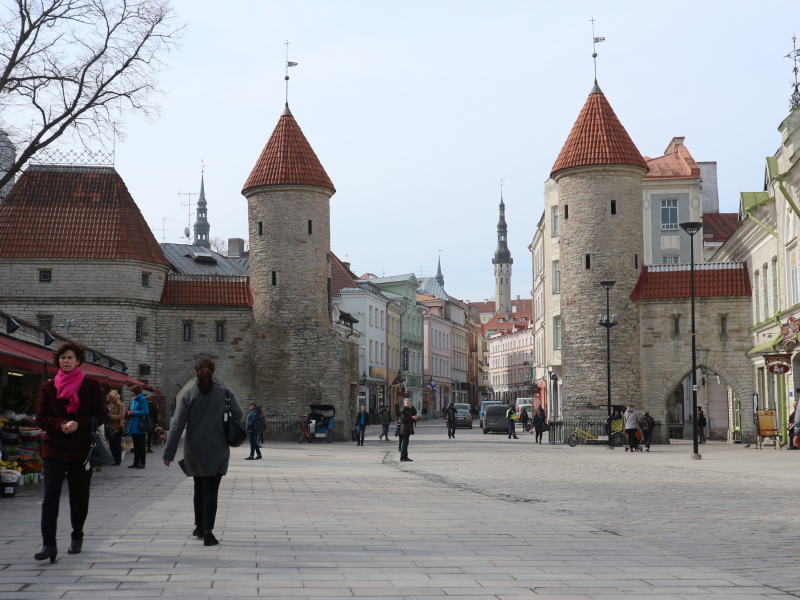
The list of cafes and restaurants could be practically endless. Only on the Town Hall Square and nearby streets, you can find at least 30 of them, so everyone can find something.
The most budget-friendly dining could be found at cafeterias in the shop-centers near the Old Town, like Lido at Solaris; the lunch offer (including main course, side dish, salad, and drink) here will cost 5-6 euros per person.
Where to stay
If you ask about my favorite place to live in Tallinn, I’ll keep it a secret (sorry, I am afraid of overbooking). Seriously, Tallinn offers such a variety of options to live in, that you can easily find a suitable accommodation: from hostels to luxury spa hotels (recommended if you are in extreme need for a fast and complete reboot). But no matter what budget you have, for your first visit, I’d recommend you find a lodging in one of the Old Town’s historical buildings in order to immerse yourself fully into the medieval atmosphere. The feeling when you step out of your hotel onto the cobblestone or see 700 year-old buildings from your window is enchanting.
Tip 4: You may save some money and choose an accommodation without breakfast. Most restaurants and cafés on the town hall square and nearby streets offer substantial breakfasts for 3-5 euro per person. It’s less expensive than breakfast at the hotel and turns your morning meal into a little adventure.
How to get there
The easiest and the fastest way to go to Tallinn is by bus. Comfortable buses leave from St. Petersburg’s main bus station every 2-3 hours and go practically to the Tallinn Center. Unlike cars, which can get stuck for hours in long queues at the border, especially on holidays and weekends, buses cross the border quickly through the “green channel”.
Tip 5: If you have more than two days, go by bus to Narva, the city on the border between Russia and Estonia and spend a day there exploring its castle and bastions. Then, take a comfortable train to Tallinn - only 2.5 hours and you are just under the Old City Walls.
I hope that my totally personalized and non-comprehensive guide can be a starting point to your journey to the magical Tallinn. It’s been waiting for you for 800 years.
